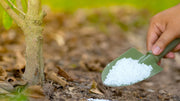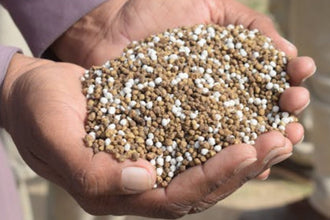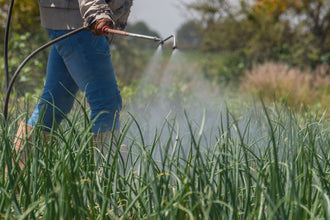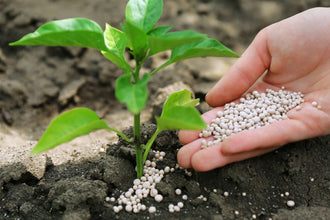
High nitrogen fertilizers work wonders for creating the lush, green garden you've always wanted. Every gardener knows that satisfying feeling of seeing plants burst with vibrant color and healthy growth. Nitrogen acts as the main ingredient that makes this happen, feeding your plants exactly what they need to produce that rich green color we all love.
You've probably walked through your garden and noticed some plants looking pale or growing slower than others. This usually means they're hungry for nitrogen. Plants actually need more nitrogen than any other nutrient, but most soils don't have enough to keep them happy. That's where high nitrogen fertilizers come in to save the day.
Understanding What Makes High Nitrogen Fertilizers Work
High nitrogen fertilizers pack more of this essential nutrient compared to phosphorus and potassium. You'll see this reflected in the NPK numbers on the package, where nitrogen appears as the first number. These products typically contain anywhere from 20% to 46% nitrogen, giving your plants a serious nutritional boost.
Plants use nitrogen to build proteins and create chlorophyll, which is basically their food-making machinery. Without enough nitrogen, your plants can't manufacture what they need to grow properly. Think of nitrogen as the fuel that powers everything your plants do.
Different Types of Nitrogen Your Plants Can Use
Not all nitrogen works the same way in your soil. Some forms give plants an immediate boost, while others release slowly over time. Ammonium nitrogen gets converted by soil bacteria before plants can use it. Nitrate nitrogen works right away but can wash out of the soil during heavy rains. Organic nitrogen sources break down gradually as tiny soil creatures do their work.
Knowing these differences helps you pick the right product for your situation. Fast-acting types work great when you need quick results in spring. Slow-release options keep feeding your plants steadily all season long.
How Plants Actually Use the Nitrogen You Give Them
Plant roots soak up nitrogen in two main ways: as nitrate or ammonium. Both types travel up through the plant to reach the leaves and growing tips. Once nitrogen gets there, it becomes part of the chlorophyll that captures sunlight to make food.
This explains why nitrogen-starved plants turn yellow from the bottom up. The older leaves give up their nitrogen to help new growth, creating that yellow pattern many gardeners recognize as a cry for help.
Where High Nitrogen Fertilizers Work Best
Leafy greens absolutely love high nitrogen fertilizers. Your lettuce, spinach, and kale will reward you with darker leaves and faster growth. Corn needs tons of nitrogen too, especially when it starts shooting up during its major growth spurt.
Grass lawns are another perfect match for high nitrogen treatments. Grass keeps growing all season long, constantly needing fresh nitrogen to stay thick and green. A well-fed lawn crowds out weeds naturally.
Getting the Timing Right
Spring applications give plants the boost they need after winter's long sleep. Apply high nitrogen fertilizer right when you see new growth starting and soil temperatures warming up. This timing lets plants take advantage of longer days and warmer weather.
Some plants need summer feeding too, especially vegetables you harvest continuously and other heavy feeders. Watch for warning signs like yellowing leaves or slow growth that tells you it's time for another application.
Warning Signs That Scream "Feed Me Nitrogen"
Your plants will tell you when they need nitrogen if you know what to look for:
-
Yellowing starts on older, lower leaves first
-
Overall pale green color instead of rich, deep green
-
Slower growth than normal
-
Smaller vegetables or fewer flowers than expected
-
Thin, weak-looking grass that lets weeds take over
Picking the Right High Nitrogen Fertilizer for Your Garden
Synthetic high nitrogen fertilizers give you exact control over what you're applying. Products like urea pack 46% nitrogen in a concentrated form that works fast. Ammonium sulfate provides 21% nitrogen plus sulfur, which many plants also need.
Organic choices include blood meal, fish emulsion, and composted chicken manure. These release nitrogen more slowly but also feed the beneficial creatures living in your soil.
Making Sense of Those NPK Numbers
High nitrogen fertilizers show ratios like 30-0-0 or 21-0-0, where that first number tells you the nitrogen percentage. Higher first numbers mean more concentrated nitrogen. Some products balance all three nutrients with ratios like 10-10-10, which works fine for general garden use but might not provide enough nitrogen for hungry plants.
Application Methods That Actually Work
Broadcasting granular fertilizer works well for large areas like vegetable gardens or lawns. Just spread it evenly and water thoroughly afterward to dissolve the granules and get nutrients down to the roots.
Liquid applications let you be more precise and get faster results. Mix water-soluble high nitrogen fertilizer according to the directions and apply it directly to the soil around your plants.

Avoiding Common Problems
Too much of a good thing can backfire with high nitrogen fertilizers. Overdoing it creates weak, sappy growth that attracts bugs and diseases. Plants might also spend so much energy growing leaves that they forget to make flowers or fruit.
Synthetic fertilizers can build up salts in the soil that hurt plant roots and kill beneficial microbes. This problem gets worse in containers where excess salts can't wash away.
Preventing Fertilizer Burn
Always apply high nitrogen fertilizer to damp soil and water right after application. This prevents concentrated fertilizer from sitting against tender roots where it can cause chemical burns. Follow package directions exactly and resist adding extra for "better" results. More isn't better with fertilizers.
Being a Good Neighbor to the Environment
Excess nitrogen can wash into groundwater or run off into streams and lakes, causing pollution problems. Only apply high nitrogen fertilizer when plants actively need it and can use it quickly. Slow-release products cost more upfront but often provide better value by reducing waste.
Organic vs Synthetic: Which High Nitrogen Option Works Better
Synthetic high nitrogen fertilizers work immediately and give you precise control over nutrients. They fix problems fast and deliver predictable results. However, they don't do anything to improve your soil's long-term health.
Organic high nitrogen fertilizers take longer to work but provide bonus benefits. They add organic matter to soil, help it hold water better, and feed the good bacteria and fungi that plants love.
Making the Smart Choice
Consider what you're trying to accomplish and how quickly you need results. Severe deficiencies might need synthetic fertilizers for a quick fix. Long-term soil improvement benefits from organic approaches.
Many successful gardeners use both strategically. Synthetic fertilizers handle emergency situations while organic amendments build better soil for the future.
Start Growing the Garden You Actually Want
High nitrogen fertilizers can completely change your gardening game when you use them right. Get a soil test first to know what you're working with instead of guessing. This prevents waste and ensures you're giving plants what they actually need.
Pay attention to what your plants tell you through their appearance and growth. Adjust your feeding program based on how they respond rather than blindly following a calendar.
Your garden deserves the nutrition it needs to thrive. Start with that soil test to understand where you stand, then choose a high nitrogen fertilizer that fits your gardening style and goals. You'll be amazed at how much difference proper feeding makes in creating the beautiful, productive garden you've been dreaming about.








